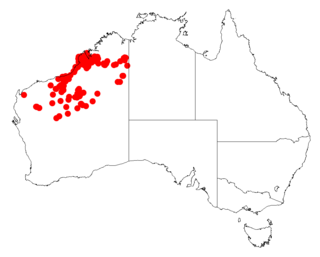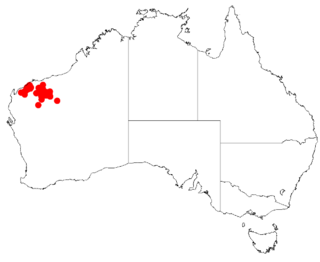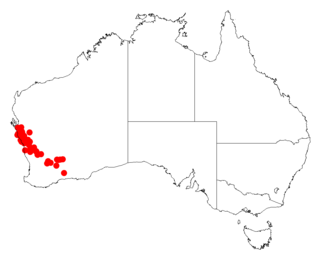
Acacia eriopoda, commonly known as the Broome pindan wattle and the narrow-leaf pindan wattle, is a species of wattle in the legume family that is native to northern Western Australia. It is also known as Yirrakulu to the Nyangumarta people.

Acacia acradenia, commonly known as Velvet Hill wattle and silky wattle, is a shrub or tree belonging to the genus Acacia and the subgenus Juliflorae. It is native to northern and central Australia. The Indigenous Australian group the Nyangumarta peoples know it as walypuna the Alyawarr call it ampwey, the Jaminjung and Ngaliwurru know it as Mindiwirri, the Jaru as binbali or gundalyji, the Kaytetye as ampweye or arwele and the Warlpiri as ngardurrkura.

Acacia ancistrocarpa, commonly known as fitzroy wattle, is a shrub belonging to the genus Acacia and the subgenus Juliflorae. The shrub is also known as fish hook wattle, pindan wattle and shiny leaved wattle.

Acacia atkinsiana, commonly known as Atkin's wattle, is a shrub belonging to the genus Acacia and the subgenus Juliflorae endemic to Australia. The indigenous peoples of the area where the shrub is found, the Kurrama peoples, know the shrub as Bilari or Pilarri.

Acacia distans is a tree belonging to the genus Acacia and the subgenus Juliflorae that is endemic to arid parts of western Australia.

Acacia effusifolia is a shrub or tree belonging to the genus Acacia and the subgenus Juliflorae. It is native to an area in the Mid West and the Wheatbelt regions of Western Australia.

Acacia hamersleyensis, also known as Karijini wattle or Hamersley Range wattle, is a tree or shrub belonging to the genus Acacia and the subgenus Juliflorae. It is endemic to a small area in central Western Australia.

Acacia hopperiana is a small tree or shrub belonging to the genus Acacia and the subgenus Juliflorae that is endemic to western Australia.

Acacia intorta is a shrub or tree belonging to the genus Acacia and the subgenus Juliflorae that is endemic to arid parts of central Western Australia.

Acacia multispicata, commonly known as spiked wattle, is a shrub belonging to the genus Acacia and the subgenus Juliflorae that is endemic to south western Australia.

Acacia oncinocarpa is a shrub or tree belonging to the genus Acacia and the subgenus Juliflorae that is endemic to northern Australia.

Acacia orthocarpa, also commonly known as Pilbara weeping wattle, needle-leaf wattle or straight-podded wattle, is a shrub or tree belonging to the genus Acacia and the subgenus Juliflorae that is endemic to tropical parts of northern Australia. The indigenous Nyangumarta peoples know it as yartupu.

Acacia paraneura, commonly known as weeping mulga, is a tree or shrub belonging to the genus Acacia and the subgenus Juliflorae. It is native to arid regions of Australia. The Indigenous Kurrama peoples know the tree as warlun.

Acacia rhodophloia, commonly known as minni ritchi or western red mulga, is a tree or shrub belonging to the genus Acacia and the subgenus Juliflorae that is endemic to a large area of arid central western Australia. The Indigenous group the Kurrama peoples know the plant as mantaru.
Acacia seclusa, commonly known as saw range wattle, is a small tree belonging to the genus Acacia and the subgenus Juliflorae that is endemic to northern Australia.

Acacia sibirica, commonly known as bastard mulga or false witchetty bush, is a tree or shrub belonging to the genus Acacia and the subgenus Juliflorae. It is native to arid areas of Australia.

Acacia signata is a tree or shrub belonging to the genus Acacia and the subgenus Juliflorae that is endemic to western Australia.

Acacia stipuligera is a tree or shrub belonging to the genus Acacia and the subgenus Juliflorae. It is native to arid and tropical parts of northern Australia.

Acacia trachycarpa, commonly known as minni ritchi, curly-bark tree, sweet-scented minni ritchi or Pilbara minni ritchi, is a shrub or tree belonging to the genus Acacia and the subgenus Juliflorae that is native to arid and semi-arid areas of Western Australia.

Acacia macdonnelliensis, commonly known as the MacDonnell mulga or the Hill mulga, is a species of Acacia native to central Australia. The Indigenous Australians the Alyawarr peoples know the plant as irrar, the Kaytetye know it as arleth-arlethe or arwele arleth-arlethe and the Western Arrernte peoples know it as irrkwarteke.




















